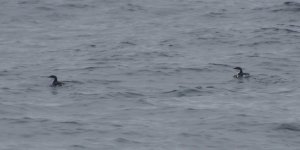25 August 2024
It was one of those plans that just grew. I needed to go to Hollister. That was half way to Panoche Valley, where Chukar have been reported this summer. If I went that far, I could swing north to the wildlife areas in Merced County in the San Joaquin Valley. I was having little luck with shorebirds on the coast, maybe I could find some there. The Chukar reports were mainly in the late afternoon, so I decided to do the route in the other direction and head first to the Central Valley sites.
An early start got me to Los Banos Wildlife Area by 7:30 AM. This is a site about 4 miles north of the town of Los Banos run by the California Department of Fish and Wildlife and managed for fishing and hunting. During the hunting season it is closed to those without the appropriate hunting permits, so it is not a place you can bird during the winter. And it turned out not to be a great place to bird in the summer, at least if you are looking for shorebirds. There were some lakes and canals with high water levels for fishing, but at this time of year there were no shallow water ponds with muddy borders that would appeal to sandpipers or plovers. There were a fair number of fishing birds, in the forms of egrets, herons, an Osprey, and a Belted Kingfisher. An elegant Swainson’s Hawk was nice to see. My eBird checklist is here:
https://ebird.org/checklist/S192973878.
I drove about half-way up Santa Fe Grade next. This is a gravel road (newly graded, the best condition I have ever seen it) that is mostly lined on either side by hunt clubs. It can be very good for waterfowl and good for shorebirds in winter, but again the ponds were mostly dry now. There were a few wet spots with a few Least Sandpipers, Black-necked Stilts, and Greater and Lesser Yellowlegs, but nothing I have not seen many times this year. The list I composed for eBird is at this web address:
https://ebird.org/checklist/S192975164.
The nearby San Luis National Wildlife Refuge was next on my route. I had hoped to query the staff at the visitor center about possible locations for shorebirds, but, in a classic example of government serving the people, the visitor center was closed, as it is all weekends and holidays, just those times when people are most likely to visit. The Waterfowl Tour Route on the refuge was dry – no shorebirds here at all. A checklist:
https://ebird.org/checklist/S192975476.
The visitor center may be at San Luis, but the real showcase of the local refuges is Merced National Wildlife Refuge. I thought it would surely have some habitat, even now. I was wrong. Twenty-seven Great Egrets roosting in a field (that should have been a pond) was the only sighting of interest. It is really surprising and rather disappointing that there is no shorebird habitat maintained on any of these refuges at this time, which is well into their migration season. eBird:
https://ebird.org/checklist/S192975928.
I drove down toward Panoche Valley, in the foothills west of the San Joaquin Valley. I stopped briefly at Mercey Hot Springs, a little resort on the way, to enquire about birding there. This used to be a place where the birding was free and Long-eared Owls roosted in the trees – I stayed overnight there once and counted 24 flying out at dusk. Then Great Horned Owls arrived and the Long-eared Owls left. (A bit of local birding fame: some birders once met actress Daryl Hannah, who was staying at the resort, there. She is said to have been quite nice and interested in the owls.) The resort wanted $15 for a short visit, which I decided not to spend as I did not expect I would find any new birds. Or any celebrities. On up Little Panoche Road is a brief winding stretch known to birders as Shotgun Pass, which leads down into Panoche Valley. This was where the Chukar had been seen. Most recent reports had the Chukars present late in the afternoon. I had zipped through the reserves so quickly that I was now about two hours ahead of schedule. I walked down the pass and back up again, drove down into Panoche Valley, took a nap, drove back up, took another nap, listened to a baseball game on the radio, and finally heard a Chukar calling. The calling bird was perched sentinel-fashion on a rock outcrop above the pass. Getting it in the scope, I could see several other Chukars nearby. Other than some owls and perhaps some storm-petrels, this is the last locally breeding bird I had yet to see this year, so I was very glad to get it. A very short eBird list, covering just my last sojourn at Shotgun Pass:
https://ebird.org/checklist/S192976485.
I made one final stop on the way in to Hollister, at Paicines Reservoir. The water level was unexpectedly high and there were lots of birds. You can only view the reservoir from a spot on the east side and at this time in the afternoon the reflection of the sunlight off the water made viewing less then optimal. There were a few sandpipers, all Least Sandpipers as far as I could tell. There were many ducks, Canada Geese, and American Coots, but I could not find anything new for my yearlist. What I did find is listed here:
https://ebird.org/checklist/S192977483.
After a long day birding it was just one new species, Chukar, and the year list is up to 377.














































